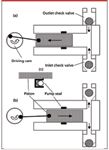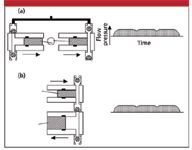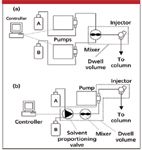LC Pumps
LCGC North America
This month's "LC Troubleshooting" installment will take a look at the design of these durable pumps and also examine some of the potential weaknesses and how to overcome them.
Here we are, more than 40 years after the initial exploration of high performance liquid chromatography (HPLC). Many things have changed, some innovations have come and gone, but the reciprocating-piston pump still remains as a key component of the LC system. We've tried pneumatically driven pumps, piston-diaphragm pumps, syringe pumps, and some other ideas, but none have proven to be superior to the reciprocating-piston pump. Yes, some changes have been made, but the basic operation remains the same. This month's "LC Troubleshooting" installment will take a look at the design of these durable pumps and also examine some of the potential weaknesses and how to overcome them.

John W. Dolan
The Basic Design
The basic design and operation of the reciprocating-piston pump is illustrated by the single-piston pump shown in Figure 1. The key components are a piston, pump seal, pump head, and a couple of check valves. The piston, usually made of sapphire, is driven back and forth in the pump head by a rotating motor. Various means have been conceived to convert the rotary motion of the motor into the bidirectional movement of the piston. Most commonly, this is done by a cam pressing against one end of the piston to push it into the pump head and a spring to push the piston back out. The pump seal is shown in the inset in Figure 1c. It is a polymer ring that fits around the piston, and a small lip forms a liquid-tight seal against the piston with the aid of a spring and liquid pressure. A pair of ruby check valves with sapphire seats are mounted on the top and bottom of the pump head. The check valves control the direction of flow through the pump. On the intake stroke (Figure 1a), the piston is withdrawn, which creates a low pressure area inside the pump head. This allows the outlet check valve to close and the inlet check valve to open, so that mobile phase flows in to fill the pump head. On the delivery stroke (Figure 1b), the piston moves into the pump head, and the inlet check valve is closed as the pressure increases. When the pressure inside the pump head exceeds the pressure in the column, the outlet check valve opens and mobile phase flows to the column. When all is working well, this simple pump design is quite reliable.

Figure 1: Single-piston reciprocating pump: (a) Pump in intake, or fill cycle; (b) pump in delivery cycle; and (c) partial section of piston showing cut-away portion of piston seal. See text for discussion.
The weak points in the design are the check valves and the pump seal. The operation of the check valves and some design improvements were discussed in the June 2008 installment of "LC Troubleshooting" (1). Contamination of the check valves can cause them to leak, and under the right circumstances, acetonitrile in the mobile phase can cause the inlet check valve to stick closed. The pump seal forms a seal against the moving piston, and although the sapphire piston is very smooth, the seal eventually will wear out. This wear is accelerated if buffer is allowed to sit in an unused pump, because the liquid behind the seal evaporates and leaves an abrasive layer of buffer crystals. These abrade the seal when the pump is restarted, and can shorten the seal life. Generally the pump seals will last 6–12 months under normal operation if buffers are rinsed from the system before shutdown.
Bubbles of air trapped in the pump head will cause the pump to under-deliver mobile phase. Bubbles can result when mobile phases are not degassed sufficiently. Fortunately, most of today's LC systems incorporate an inline vacuum degasser to degas the mobile phase automatically. So if the pump is purged of bubbles when it is started, bubble problems in the pump are not a common problem today — they were the bane of the chromatographer in years past.
The original reciprocating-piston pumps were crude by today's standards. I remember using the Milton–Roy Minipump, one of the standard pumps in the late 1960s and early 1970s, particularly for laboratory-built systems that were common in graduate school laboratories. The flow rate was controlled by adjusting a stop that limited the distance the piston could move. With a single-piston design, the pump spent half the time filling and half the time delivering mobile phase. This resulted in pulses of pressure and flow that were reflected in a fluctuating baseline and short column lifetimes of the then-poorly-packed columns. Huge pulse dampeners, sometimes 50–100 mL in volume, were required to reduce the pulses to an acceptable level. Refinements in the shape of the driving cam and the use of stepper-driven motors helped to minimize pulses with single-piston pumps, but as other aspects of the LC system were improved, single-piston pumps were not sufficiently pulse-free to be acceptable.
Enter the Dual-Piston Pump
The simple cure for the pulsating nature of the single-piston pump was to operate two such pumps so that when one piston was filling, the other was delivering solvent. This is shown in the diagram in Figure 2a, where the left-hand piston is at the end of its fill stroke and the right-hand piston is at the end of its delivery stroke. The solvent delivered from both pump heads is combined into a single flow-stream. Because one piston is always in the delivery cycle, solvent flows continuously to the column and pulses are minimized or eliminated. In practice, dual-piston pumps are configured so that the pistons are mounted side-by-side in parallel. The dual-piston pump was developed early in the history of HPLC and remains as one of the two most popular designs in use today.

Figure 2: Two-piston pump designs: (a) Dual-piston pump with left piston in fill cycle and right piston in delivery cycle and (b) accumulator-piston pump with top piston in delivery cycle and bottom piston in fill cycle. Arrows show direction of motion of pistons; pressure and flow profiles are shown at right. See text for discussion.
Accumulator-Piston Pump
A later development in pump design is the accumulator-piston pump shown in Figure 2b. This also is called a tandem-piston pump. In this design, the two pistons deliver solvent at two different flow rates. For example, if the pump of Figure 2b is set to deliver 1 mL/min of solvent to the column, the top piston (shown at the end of the delivery stroke) pumps at 1 mL/min. Meanwhile, the bottom piston fills at 2 mL/min. Next, the top piston fills at 1 mL/min. The 2 mL/min delivered by the bottom piston is split so that 1 mL/min serves to fill the top piston and the other 1 mL/min flows directly to the column. In this manner, solvent always flows to the column at 1 mL/min.
Check Valves
One purported advantage of the accumulator-piston pump is the reduced number of check valves. In the diagram of Figure 2b, three ball-type check valves are used, as opposed to the four check valves required by the dual-piston pump of Figure 2a. Furthermore, if there is constant flow to the column, supplied by either the top or bottom piston, the outlet check valve is always open, so it is not needed. Some implementations of this pump do not use an outlet check valve — now only two check valves are used. If the inlet check valve is replaced by an active check valve (see discussion in reference 1), only one ball-type check valve remains. This is in contrast to two ball-type check valves if the inlet check valves are replaced by active check valves in the dual-piston pump. In both cases, the number of check valves is reduced for more reliable operation.
Online Mixing
The next advance in pump technology was the addition of the ability to mix two or more solvents online. Before this, isocratic mobile phases (for methods in which the mobile phase composition is constant) were hand-mixed. Gradients (in which the mobile phase composition changes during the run) were formed by use of a crude dilution flask, siphon, or other gradient former. Online mixing comes in two primary forms — high- and low-pressure mixing, illustrated for two-solvent mixing systems in Figure 3.

Figure 3: Online mixing systems: (a) High-pressure mixing and (b) low-pressure mixing. See text for discussion.
High-pressure mixers are the simplest in concept (Figure 3a). Two separate pumps are used, with one pump delivering the A-solvent (water or buffer for reversed-phase separations) and the second delivering the B-solvent (generally acetonitrile or methanol). The ratio of the flow rates for the two pumps determines the A/B ratio. Constant flow from both pumps is used for isocratic separations, whereas changing flow rates of the two pumps can form a gradient at constant flow rate.
Low-pressure mixers came a bit later. In these, two, three, or four solvents are combined at a low-pressure proportioning manifold prior to the pump (Figure 3b for a two-solvent system). A single pump operates at constant flow rate. The solvent mixture is controlled by alternately opening proportioning valves to allow one of the solvents to flow into the proportioning manifold. For isocratic mobile phases, the solvent proportions stay constant, whereas for gradients, the open-close cycles of the various valves is programmed to vary during the run. This design easily can handle four different solvents, whereas the high-pressure mixing requires a separate pump for each solvent, and is limited to binary mixtures unless more pumps are added. It should be obvious that continuing improvements in pump controllers have improved the precision and accuracy of blending solvents online.
In both designs of online solvent blending, active or static mixers are used to facilitate mixing the mobile phase. All of the various components from the point the solvents are first blended until they reach the head of the column comprise the dwell volume, as shown inside the dashed lines for the systems in Figure 3. This dwell volume is of little concern for isocratic separations. For gradients, however, the dwell volume becomes more important, because it results in a delay between the time the sample is injected and the time the gradient reaches the head of the column. Differences in dwell volume account for one of the primary reasons gradient methods are difficult to transfer from one LC system to another. LC systems designed for conventional separations (for example, using 150 mm × 4.6 mm columns) have dwell volumes in the range of =1.5–4 mL. A more detailed discussion of the effects of dwell volume and how to measure it was presented in an earlier "LC Troubleshooting" column (2).
There is a delicate balance between having the mixing volume large enough to provide acceptable solvent mixing and having the dwell volume small enough that excessive gradient delay is not encountered. Furthermore, if the mixing volume is too large relative to the gradient volume (gradient run time × flow rate), gradient distortion can occur (3). For a 20-min gradient at 1.5 mL/min, as might be typical for a 150 mm × 4.6 mm column, the gradient volume is 30 mL. For the equivalent gradient with a 50 mm × 2.1 mm column, as is used commonly for LC methods with mass spectrometry detection (LC–MS), a 6-min gradient at 0.3 mL/min (gradient volume = 2 mL) might be used. It has been reported (3) that the mixing volume (which accounts for 25–50% of the dwell volume) should be ≤10% of the gradient volume. This means that for good performance with the newest column technology, such as 50 mm × 2.1 mm columns containing 3-μm particles or 50–100 mm × 1.0 mm columns with sub-3-μm particles, dwell volumes of <1 mL are required. LC systems that accommodate these separation conditions must have small internal volumes, yet provide adequate solvent mixing.
Conclusions
The simple reciprocating-piston pump that was used in the earliest LC systems remains as the central design element of today's higher performance pumping systems. Dual-piston and accumulator-piston pump designs are most common today, and design refinements allow them to generate highly precise and accurate isocratic or gradient mobile phases. The challenges of smaller-particle columns, pressures of more than 6000 psi (400 bar), and faster gradient runs have continued to keep pump designers busy modifying today's pumps for tomorrow's applications.
John W. Dolan
"LC Troubleshooting" Editor John W. Dolan is Vice-President of LC Resources, Walnut Creek, California; and a member of LCGC's editorial advisory board. Direct correspondence about this column to "LC Troubleshooting," LCGC, Woodbridge Corporate Plaza, 485 Route 1 South, Building F, First Floor, Iselin, NJ 08830, e-mail John.Dolan@LCResources.com.
For an ongoing discussion of LC trouble-shooting with John Dolan and other chromatographers, visit the Chromatography Forum discussion group at http://www.chromforum.com.
References
(1) J.W. Dolan, LCGC 26(6), 532–538 (2008).
(2) J.W. Dolan, LCGC 24(5), 458–466 (2006).
(3) G. Hendriks, J.P. Franke, and D.R.A. Uges, J. Chromatogr., A 1089, 193 (2005).
Investigating 3D-Printable Stationary Phases in Liquid Chromatography
May 7th 20253D printing technology has potential in chromatography, but a major challenge is developing materials with both high porosity and robust mechanical properties. Recently, scientists compared the separation performances of eight different 3D printable stationary phases.
Characterizing Polyamides Using Reversed-Phase Liquid Chromatography
May 5th 2025Polyamides can be difficult to characterize, despite their use in various aspects of everyday life. Vrije Universiteit Amsterdam researchers hoped to address this using a reversed-phase liquid chromatography (RPLC)-based approach.
New Method Explored for the Detection of CECs in Crops Irrigated with Contaminated Water
April 30th 2025This new study presents a validated QuEChERS–LC-MS/MS method for detecting eight persistent, mobile, and toxic substances in escarole, tomatoes, and tomato leaves irrigated with contaminated water.
University of Tasmania Researchers Explore Haloacetic Acid Determiniation in Water with capLC–MS
April 29th 2025Haloacetic acid detection has become important when analyzing drinking and swimming pool water. University of Tasmania researchers have begun applying capillary liquid chromatography as a means of detecting these substances.

.png&w=3840&q=75)

.png&w=3840&q=75)



.png&w=3840&q=75)



.png&w=3840&q=75)












